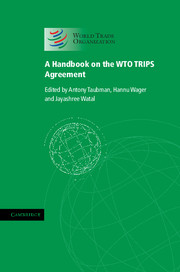Book contents
- Frontmatter
- Contents
- Figures
- Boxes
- Tables
- Preface
- Acknowledgements
- Acronyms and abbreviations
- I Introduction to the TRIPS Agreement
- II Copyright and related rights
- III Trademarks
- IV Geographical indications
- V Patents
- VI Industrial designs, layout-designs of integrated circuits, undisclosed information, anti-competitive practices
- VII Enforcement
- VIII Dispute prevention and settlement
- IX TRIPS and Public Health
- X Current TRIPS issues
- Appendix 1 Guide to TRIPS notifications
- Appendix 2 Guide to TRIPS documents
- Annexes TRIPS Handbook
- Index
V - Patents
Published online by Cambridge University Press: 05 May 2012
- Frontmatter
- Contents
- Figures
- Boxes
- Tables
- Preface
- Acknowledgements
- Acronyms and abbreviations
- I Introduction to the TRIPS Agreement
- II Copyright and related rights
- III Trademarks
- IV Geographical indications
- V Patents
- VI Industrial designs, layout-designs of integrated circuits, undisclosed information, anti-competitive practices
- VII Enforcement
- VIII Dispute prevention and settlement
- IX TRIPS and Public Health
- X Current TRIPS issues
- Appendix 1 Guide to TRIPS notifications
- Appendix 2 Guide to TRIPS documents
- Annexes TRIPS Handbook
- Index
Summary
Introduction
This chapter explains the provisions of Section 5 of Part II of the TRIPS Agreement entitled ‘Patents’. Section 5, which contains eight articles, from Article 27 to Article 34, sets out the obligations of Members with respect to standards concerning the availability, scope and use of patents. Starting with a general explanation of terms, this chapter goes on to explain each specific provision in this Section of the TRIPS Agreement.
What are patents?
The term ‘patent’ is not specifically defined in the TRIPS Agreement. A patent is the title given to the IPR that is granted to protect new inventions. A patent, which is granted by the authorities in a specified jurisdiction, gives its owner an exclusive right to prevent others from exploiting the patented invention in that jurisdiction for a limited period of time without his or her authorization, subject to a number of exceptions.
The term ‘invention’ is not defined in the TRIPS Agreement. One informal definition (used, for example, in some WIPO capacity building materials) characterizes an invention as a new solution to a technical problem. Other approaches to defining ‘invention’ can also be found in national laws. Many national laws exclude such material as scientific theories, aesthetic creations, schemes, and rules and methods for performing mental acts. These activities do not aim at any direct technical result but are rather of an abstract and intellectual character.
- Type
- Chapter
- Information
- A Handbook on the WTO TRIPS Agreement , pp. 95 - 115Publisher: Cambridge University PressPrint publication year: 2012



